In my granny square blankets, I use one color in each square. Some squares have the traditional open look, some are solid, and some pieces are half-squares, used to fill in edges when the squares are put on point.
Here are scans and charts for some of these pieces. In the charts, if it's an open circle, it's a chain, if it's a solid circle, it's a slip stitch, and if it's a T with a single diagonal cross bar in the middle, it's a USdc/UKtrc.
Please note: when I join rounds, I do not join at the top of the chains. I find I get a neater result if I join at the dc that immediately follows those chains. In practical terms, this means you need to swatch if you are going to make either of the full "turned" squares. A dc works well as the joining stitch for me, but if you prefer to join at the top of the chain, you may find that hdc or even sc will work better.
Squares can be either fairly solid, or more open. In addition, they can be done with or without turning. Turning the work gives a more uniform look to the front and back, and to my eye, it also emphasizes the squareness of the pattern. Swatch both and see which you prefer.
Solid "spiral" squares
|
Scan of completed square (Click for bigger) |
Chart of stitches | Direction of stitches |
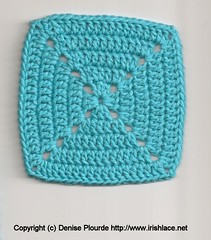 |
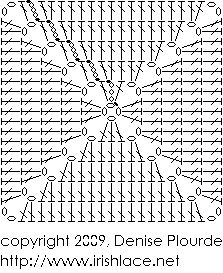
|
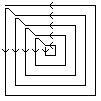
|
Solid "turned" squares
|
Scan of completed square (Click for bigger) |
Chart of stitches | Direction of stitches |
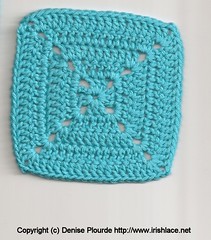
|
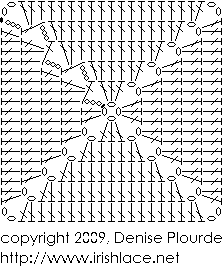
|
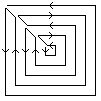
|
Open "spiral" squares
|
Scan of completed square (Click for bigger) |
Chart of stitches | Direction of stitches |

|
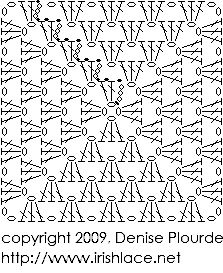
|

|
Open "turned" squares
|
Scan of completed square (Click for bigger) |
Chart of stitches | Direction of stitches |

|
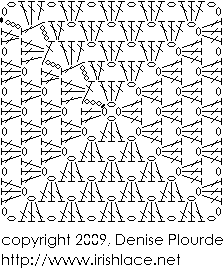
|

|
Some notes about solid squares
If you count the number of double crochet stitches on a side per round, it looks like this:Round 1: 3
Round 2: 7
Round 3: 11
Round 4: 15
Round 5: 19
Round 6: 23
Round 7: 27
Round X: 4X - 1
One thing I've noticed is that as the number of rounds gets higher, the square starts to get ruffly. I don't have the increases set up quite right. However, since the extra seems to be taken up nicely when the squares are put together, I don't worry about it. At 8 rounds and beyond, I would need to adjust my increases.
I use worsted weight yarn, and a US size H8 (5mm) hook. When I make squares with that hook and my standard tension, I can estimate fairly accurately the amount of yarn I need.
3 round squares: 35-36 per 8oz skein: 273 (13*21) to make coverlet for single bed
4 round squares: 21 per 8oz skein: 279 (17*17) to make 7' square blanket for father
6 round squares: 11-12 per 8oz skein: 77 (7*11) to make coverlet for single bed
7 round squares: 8 per 8oz skein: 60 (6*10) to make coverlet for single bed
In addition, for the 60-square blankets, I need about 10 oz for seaming and for bordering (2 rounds of sc). For blankets with smaller squares (and more seams), I would need more. I would work on the assumption that I get 300-400 sc out of an ounce (depending on whether I'm doing the really short seams in the scarves or doing long unbroken stretches), and do the math from there.